
The 6th Marine Division was a United States Marine Corps World War II infantry division formed in September 1944. During the invasion of Okinawa it saw combat at Yae-Take and Sugar Loaf Hill and was awarded a Presidential Unit Citation. The 6th Division had also prepared for the invasion of Japan before the war ended. After the war it served in Tsingtao, China, where the division was disbanded on April 1, 1946, being the only Marine division to be formed and disbanded overseas and never set foot in the United States.

The 3rd Marine Division is a division of the United States Marine Corps based at Camp Courtney, Marine Corps Base Camp Smedley D. Butler in Okinawa, Japan. It is one of three active duty infantry divisions in the Marine Corps and together with the 1st Marine Aircraft Wing (1stMAW) and the 3rd Marine Logistics Group forms the III Marine Expeditionary Force. The division was first formed during World War II and saw four years of continuous combat in the Vietnam War. Today, elements of the 3rd Marine Division are continuously forward deployed and forward postured to carry out the US Government's mission of a Free and Open Indo-Pacific in conjunction with its sister services.
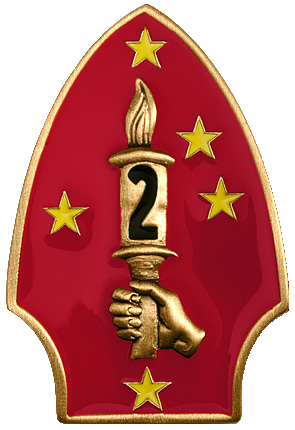
The 2nd Marine Division is a division of the United States Marine Corps, which forms the ground combat element of the II Marine Expeditionary Force. The division is based at Marine Corps Base Camp Lejeune, North Carolina and headquartered at Julian C. Smith Hall.

The 5th Marine Division was a United States Marine Corps ground combat division which was activated on 11 November 1943 at Camp Pendleton, California during World War II. The 5th Division saw its first combat action during the Battle of Iwo Jima in 1945 where it sustained the highest number of casualties of the three Marine divisions of the V Amphibious Corps. The 5th Division was to be part of the planned invasion of the Japan homeland before Japan surrendered. Assault troops of the 5th Division were included in the Presidential Unit Citation awarded to the V Amphibious Corps for extraordinary heroism on Iwo Jima from 19 to 28 February 1945. The 5th Division was deactivated on 5 February 1946.
1st Battalion, 8th Marines (1/8) is an infantry battalion in the United States Marine Corps based out of Marine Corps Base Camp Lejeune, North Carolina. The battalion consists of approximately 1000 Marines and sailors and is nicknamed "The Beirut Battalion." The battalion falls under the command of the 6th Marine Regiment and the 2nd Marine Division.

The 6th Marine Regiment is an infantry regiment of the United States Marine Corps based at Marine Corps Base Camp Lejeune, North Carolina. The regiment falls under the command of the 2nd Marine Division of the II Marine Expeditionary Force. Its combat history dates back to World War I when they were part of the American Expeditionary Force. They fought in the Pacific Theater in World War II, most notably at the battles of Guadalcanal, Tarawa, Saipan, Tinian and Okinawa. More recently, the regiment has seen combat during the Gulf War and in support of Operation Iraqi Freedom.

The 22nd Marine Regiment is an inactive United States Marine Corps infantry regiment. The regiment was commissioned in 1942 and was placed under the command of the 1st Provisional Marine Brigade in 1944, and the 6th Marine Division in 1945. It took part in fighting at the battles of Eniwetok, Guam, and Okinawa. The regiment also participated in the occupation of northern China following the war. 22d Marines was decommissioned in March 1946.
The Scout and Sniper Company of 6th Marine Division was the division reconnaissance asset for the regimental commanders. It was created by former Marine Raider Major Anthony "Cold Steel" Walker to form a scout company from Company H from out of one of the regiments of 6th Marine Division. The Scout Company deactivated, along with 6th Marine Division, after the end of World War II.

Victor France Bleasdale was a brigadier general in the United States Marine Corps. He was awarded the Navy Cross and Distinguished Service Cross for his actions during the Battle of Blanc Mont Ridge in World War I. Later he received a second Navy Cross for his service at the Battle of San Fernando during the Second Nicaraguan Campaign.

Robert Dewey Bohn was a highly decorated officer of the United States Marine Corps, reaching the rank of major general. He served in three wars and concluded his career as commanding general of Marine Corps Base Camp Lejeune.

Brigadier General Austin Conner Shofner was a United States Marine Corps officer who was captured during the Battle of Corregidor and then part of the only successful escape from a Japanese prisoner of war camp. He joined the Philippine resistance, and later returned to command units of the Marine Corps in the battles of Peleliu and Okinawa.
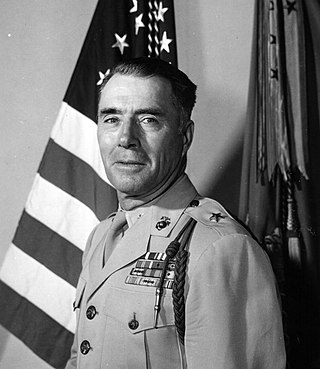
William John Whaling was a highly decorated Major general in the United States Marine Corps and an expert in jungle warfare during the Pacific War. He also competed as a sport shooter in the 1924 Summer Olympics, where he finished in 12th place in the 25 m rapid fire pistol competition.

Rathvon McClure Tompkins was a highly decorated United States Marine Corps major general. He saw combat in World War II, the Korean War, the Vietnam War and led Marine units during the Dominican Civil War. Tompkins is well known for his part as commander of the 3rd Marine Division during the Battle of Khe Sanh in Vietnam.

Major General Gregon Albert Williams was a highly decorated officer of the United States Marine Corps who served in World War II and the Korean War. He commanded the 6th Marine Regiment during the Battle of Okinawa and later served as the chief of staff of 1st Marine Division.

Austin Roger Brunelli was a highly decorated combat veteran of World War II and the Korean War. As the commanding officer of the 1st Battalion, 24th Marines during the Battle of Iwo Jima, he was awarded the Navy Cross, the United States military's second-highest decoration awarded for valor in combat. He later served as chief of staff of the 1st Marine Division in Korea and commanding general of Camp Lejeune.

August Larson was a highly decorated officer of the United States Marine Corps with the rank of major general, who is most noted for his service as commanding officer of 22nd Marine Regiment during the Battle of Okinawa and later as director of personnel at Headquarters Marine Corps.
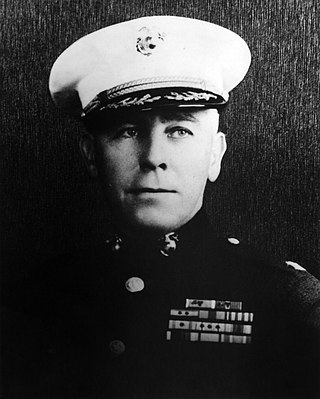
Richard Potts Ross Jr. was a highly decorated officer of the United States Marine Corps with the rank of brigadier general. He is most noted for his service with the 1st Marine Division during the Battle of Okinawa and later during the Occupation of North China.
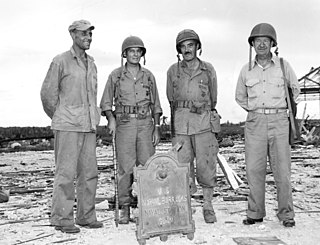
Merlin Frederick Schneider was a highly decorated officer in the United States Marine Corps with the rank of brigadier general. He is most noted as commanding officer of 22nd Marine Regiment during the Recapture of Guam in July 1944, for which he received the Navy Cross, the United States military's second-highest decoration awarded for valor in combat.

Robert Burneston Luckey was a decorated officer in the United States Marine Corps with the rank of lieutenant general. A veteran of several wars, Luckey completed his career as commanding general, Fleet Marine Force, Atlantic.
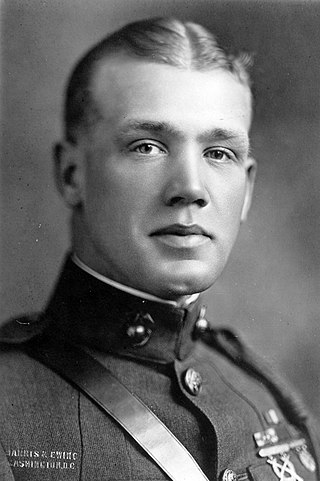
Harold Cyrus Roberts was a highly decorated officer in the United States Marine Corps with the rank of colonel. He was the recipient of three Navy Crosses, the United States military's second-highest decoration awarded for valor in combat.




















